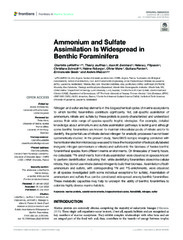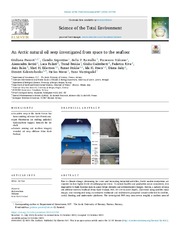Blar i forfatter "Panieri, Giuliana"
-
The Agenda 2030 and the Imperative for Research and Education for the Climate and the Oceans
Panieri, Giuliana; Poto, Margherita Paola; Murray, Emily Margaret (Chapter; Bokkapittel, 2024-05-23)This chapter sets the scene and provides background information regarding the primary objective of the book: to contribute to the knowledge base for climate education and research, with a specific focus on the oceans and water. Within this framework, the chapter situates educational and research strategies that specifically focus on ocean literacy, developed and coordinated by the authors over the ... -
Ammonium and Sulfate Assimilation Is Widespread in Benthic Foraminifera
LeKieffre, Charlotte; Jauffrais, Thierry; Bernhard, Joan M.; Filipsson, Helena L.; Schmidt, Christiane; Roberge, Helene; Maire, Olivier; Panieri, Giuliana; Geslin, Emmanuelle; Meibom, Anders (Journal article; Tidsskriftartikkel; Peer reviewed, 2022-07-20)Nitrogen and sulfur are key elements in the biogeochemical cycles of marine ecosystems to which benthic foraminifera contribute significantly. Yet, cell-specific assimilation of ammonium, nitrate and sulfate by these protists is poorly characterized and understood across their wide range of species-specific trophic strategies. For example, detailed knowledge about ammonium and sulfate assimilation ... -
An Arctic analogue for the future exploration of possible biosignatures on Enceladus
Franchi, F.; Túri, M.; Lakatos, G.; Rahul, K.K.; Mifsud, D.V.; Panieri, Giuliana; Rácz, R.; Kovács, S.T.S.; Furu, E.; Huszánk, R.; McCullough, R.W.; Juhász, Z. (Journal article; Tidsskriftartikkel; Peer reviewed, 2025-01-23)Methane-rich emissions to the seafloor along the Arctic mid-oceanic ridge hold strong astrobiological significance, as they may represent analogues of putative hydrothermal vent environments on Enceladus. Although such environments on Enceladus would be ideal to sample in future astrobiological missions, this may not be possible due to technological and logistical limitations. As such, searching for ... -
An Arctic natural oil seep investigated from space to the seafloor
Panieri, Giuliana; Argentino, Claudio; Ramalho, Sofia P.; Vulcano, Francesca; Savini, Alessandra; Fallati, Luca; Brekke, Trond; Galimberti, Giulia; Riva, Federica; Balsa, João; Eilertsen, Mari Heggernes; Stokke, Runar; Steen, Ida Helene; Sahy, Diana; Kalenitchenko, Dimitri Stanislas Desire; Bünz, Stefan; Mattingsdal, Rune (Journal article; Tidsskriftartikkel; Peer reviewed, 2023-10-19)Due to climate change, decreasing ice cover and increasing industrial activities, Arctic marine ecosystems are expected to face higher levels of anthropogenic stress. To sustain healthy and productive ocean ecosystems, it is imperative to build baseline data to assess future changes. Herein, a natural oil seep site offshore western Svalbard (Prins Karls Forland, PKF, 80–100 m water depth), discovered ... -
Benthic Foraminifera in Arctic Methane Hydrate Bearing Sediments
Dessandier, Pierre-Antoine; Borrelli, Chiara; Kalenitchenko, Dimitri; Panieri, Giuliana (Journal article; Tidsskriftartikkel; Peer reviewed, 2019-12-10)Benthic foraminifera have been widely used as proxy for paleo-methane emissions, mainly based on their stable isotopic signature. In cold seeps, the ecology of these organisms remains uncertain, in particular their ability to thrive during active phases of seepage. In this study, we evaluate the benthic foraminiferal response to methane seepage in Arctic sediments. We do so by examining living and ... -
The benthic foraminiferal δ34S records fux and timing of paleo methane emissions
Borrelli, Chiara; Gabitov, R.I.; Liu, M.-C.; Hertwig, A.T.; Panieri, Giuliana (Journal article; Tidsskriftartikkel; Peer reviewed, 2020-01-28)In modern environments, pore water geochemistry and modelling simulations allow the study of methane (CH<sub>4</sub>) sources and sinks at any geographic location. However, reconstructing CH<sub>4</sub> dynamics in geological records is challenging. Here, we show that the benthic foraminiferal δ<sup>34</sup>S can be used to reconstruct the fux (i.e., difusive vs. advective) and timing of CH<sub>4</sub> ... -
Biogeochemical impact of historical submarine mine tailings on benthic ecosystems in the Repparfjord (Northern Norway)
Hoff, Marie; Argentino, Claudio; Huljek, Laura; Fiket, Zeljka; Mun, Yulia; Barrenechea Angeles, Inés; Strmic Palinkas, Sabina; Panieri, Giuliana (Journal article; Tidsskriftartikkel; Peer reviewed, 2024-03-08)Historical copper mine tailings deposited in the Repparfjord, Northern Norway, provided new insight into the biogeochemical impact of submarine tailings disposals on high-latitude coastal ecosystems. The submarine tailings disposal in the Repparfjord represents a product of mining activities between 1972 and 1979. Their environmental impact has been extensively studied during the last decade, but ... -
Biogeochemical investigations of methane seepage at the ultraslow-spreading Arctic mid-ocean ridge: Svyatogor ridge, Fram Strait
Argentino, Claudio; Borrelli, Chiara; Akinselure, Abidemi; Correa-Diaz, Melyssa; Panieri, Giuliana (Journal article; Tidsskriftartikkel; Peer reviewed, 2024-02-13)The Arctic continental shelves are important reservoirs of methane stored in gas hydrates and deeper geological formations. However, little is known about methane dynamics in deeper oceanic settings such as mid-ocean ridges, mainly due to operational challenges related to their remoteness. This study investigates a recently discovered methane seepage environment at Svyatogor Ridge, a sediment-covered ... -
Biogeochemistry and timing of methane-derived carbonate formation at Leirdjupet fault complex, SW Barents sea
Argentino, Claudio; Lee, Amicia; Fallati, Luca; Sahy, Diana; Birgel, Daniel; Peckmann, Jörn; Bünz, Stefan; Panieri, Giuliana (Journal article; Tidsskriftartikkel; Peer reviewed, 2022-10-25)The origin of modern seafloor methane emissions in the Barents Sea is tightly connected to the glacio-tectonic and oceanographic transformations following the last ice age. Those regional events induced geological structure re-activation and destabilization of gas hydrate reservoirs over large areas of the European continental margins, sustaining widespread fluid plumbing systems. Despite the ... -
Biomarker and isotopic composition of seep carbonates record environmental conditions in two Arctic methane seeps
Yao, Haoyi; Panieri, Giuliana; Lehmann, Moritz F; Himmler, Tobias; Niemann, Helge (Journal article; Tidsskriftartikkel; Peer reviewed, 2021-02-12)Present-day activity of cold-seeps in the ocean is evident from direct observations of methane emanating from the seafloor, the presence of chemosynthetic organisms, or the quantification of gas concentrations in the water column and pore water solutes. Verifying past cold seep activity and biogeochemical characteristics is more challenging but may be reconstructed from proxy records of authigenic ... -
Bivalve shell horizons in seafloor pockmarks of the last glacial-interglacial transition suggest a thousand years of methane emissions in the Arctic Ocean
Ambrose, William; Panieri, Giuliana; Schneider, Andrea; Plaza-Faverola, Andreia; Carroll, Michael Leslie; Åström, Emmelie; Locke, W.L.; Carroll, JoLynn (Journal article; Tidsskriftartikkel; Peer reviewed, 2015-11-05)We studied discrete bivalve shell horizons in two gravity cores from seafloor pockmarks on the Vestnesa Ridge (1200 m water depth) and western Svalbard (798000 N, 068550 W) to provide insight into the temporal and spatial dynamics of seabed methane seeps. The shell beds, dominated by two genera of the family Vesicomyidae: Phreagena s.l. and Isorropodon sp., were 20–30 cm thick and centered at ... -
Carbon isotope (d13C) excursions suggest times of major methane release during the last 14 ka in Fram Strait, the deep-water gateway to the Arctic
Consolaro, Chiara; Rasmussen, Tine Lander; Panieri, Giuliana; Mienert, Jurgen; Bünz, Stefan; Sztybor, Kamila (Journal article; Tidsskriftartikkel; Peer reviewed, 2014) -
Characterization of Carbonate Crust from a Recently Discovered Methane Seep on the North Atlantic Continental Margin of the USA
Gabitov, Rinat; Borrelli, Chiara; Buettner, Jacob; Kirkland, Brenda; Skarke, Adam; Trail, Dustin; Garner, Brittany; Testa, Maurice; Wahidi, Mahnaz; Hoff, Christopher; Khasanov, Salavat; Panieri, Giuliana; Thirumalai, Roobanvenkatesh; Thomas, Jay; Weremeichik, Jeremy; Zverkova, Irina (Journal article; Tidsskriftartikkel; Peer reviewed, 2019-02-26)This study is focused on mineralogical and chemical characterization of an authigenic carbonate rock (crust) collected at a recently discovered cold seep on the US North Atlantic continental margin. X-ray diffraction (XRD) and scanning electron microscopy (SEM) indicate that the carbonate rock is composed of microcrystalline aragonite cement, white acicular aragonite crystals (AcAr), equant quartz ... -
Characterizing Håkon Mosby Mud Volcano (Barents Sea) cold seep systems by combining ROV-based acoustic data and underwater photogrammetry
Fallati, Luca; Panieri, Giuliana; Savini, Alessandra; Varzi, Andrea Giulia; Argentino, Claudio; Bünz, Stefan (Journal article; Tidsskriftartikkel; Peer reviewed, 2023-10-31)Cold-seep systems have a unique geo-ecological significance in the deep-sea environment. They impact the variability of present-day submarine sedimentary environments, affecting the evolution of the landscape over time and creating a variety of submarine landforms, one of which is Mud Volcanoes (MVs). MVs are submarine landforms form due extrusion of mud, fluids, and gas, mainly methane, from deeper ... -
Complementary biomarker-based methods for characterising Arctic sea ice conditions: A case study comparison between multivariate analysis and the PIP25 index
Koseoglu, Denizcan; Belt, Simon T.; Smik, Lukas; Yao, Haoyi; Panieri, Giuliana; Knies, Jochen (Journal article; Tidsskriftartikkel; Peer reviewed, 2017-11-10)The discovery of IP25 as a qualitative biomarker proxy for Arctic sea ice and subsequent introduction of the so-called PIP25 index for semi-quantitative descriptions of sea ice conditions has significantly advanced our understanding of long-term paleo Arctic sea ice conditions over the past decade. We investigated the potential for classification tree1 (CT) models to provide a further approach ... -
Connecting with The Deep: Lifelong Learning (LLL) and Marine Sustainability
Johansen, Caroline; Williams, Rhianon; Xylouri, Ourania; Panieri, Giuliana (Chapter; Bokkapittel, 2024-05-23)This chapter frames marine sustainability within ongoing global and regional initiatives in lifelong learning and adult education. The authors of this chapter argue that to achieve the ambitious targets set out in the SDGs, our adult population must be able to recognise, engage with, and act upon economic, social, and environmental challenges. The authors of this chapter present the many barriers ... -
Contrasting Methane Seepage Dynamics in the Hola Trough Offshore Norway: Insights From Two Different Summers
Ferré, Benedicte; Barreyre, Thibaut; Bünz, Stefan; Argentino, Claudio; Corrales-Guerrero, Jorge; Dølven, Knut Ola; Stetzler, Marie Helene Paula; Fallati, Luca; Sert, Muhammed Fatih; Panieri, Giuliana; Rastrick, Samuel; Kutti, Tina; Moser, Manuel (Journal article; Tidsskriftartikkel; Peer reviewed, 2024-07-09)This study investigates the temporal variations in methane concentration and flare activity in the Hola trough (offshore Norway) during May 2018 and June 2022. Between these time periods, methane seep activity exhibits 3.5 times increase, as evidenced by hydroacoustic measurements. As the seep area in the Hola trough is constantly within the hydrate stability zone, the observed increase cannot be ... -
Deposit-feeding of Nonionellina labradorica (foraminifera) from an Arctic methane seep site and possible association with a methanotroph
Schmidt, Christiane; Geslin, Emmanuelle; Bernhard, Joan M.; LeKieffre, Charlotte; Svenning, Mette Marianne; Roberge, Helene; Schweizer, Magali; Panieri, Giuliana (Journal article; Tidsskriftartikkel; Peer reviewed, 2022-08-30)Several foraminifera are deposit feeders that consume organic detritus (dead particulate organic material with entrained bacteria). However, the role of such foraminifera in the benthic food web remains understudied. Foraminifera feeding on methanotrophic bacteria, which are 13C-depleted, may cause negative cytoplasmic and/or calcitic δ13C values. To test whether the foraminiferal diet includes ... -
Diagenetic alteration of benthic foraminifera from a methane seep site on Vestnesa Ridge (NW Svalbard)
Schneider, Andrea; Cremiere, Antoine; Panieri, Giuliana; Lepland, Aivo; Knies, Jochen (Journal article; Tidsskriftartikkel; Peer reviewed, 2017-03-08)Anomalously low δ<sup>13</sup>C values in foraminiferal calcite tests are due to diagenetic alteration in methane seep sites. Our study applies diagenetically altered fossil benthic foraminiferal tests as geochemical tracers in reconstructing natural past methane seepage episodes at Vestnesa Ridge offshore NW Svalbard. We combine examinations of the test wall microstructure, mineralogical and stable ... -
Dynamic and history of methane seepage in the SW Barents Sea: new insights from Leirdjupet Fault Complex
Argentino, Claudio; Waghorn, Kate Alyse; Vadakkepuliyambatta, Sunil; Polteau, Stephane; Bünz, Stefan; Panieri, Giuliana (Journal article; Tidsskriftartikkel; Peer reviewed, 2021-02-23)Methane emissions from Arctic continental margins are increasing due to the negative effect of global warming on ice sheet and permafrost stability, but dynamics and timescales of seafloor seepage still remain poorly constrained. Here, we examine sediment cores collected from an active seepage area located between 295 and 353 m water depth in the SW Barents Sea, at Leirdjupet Fault Complex. The ...


 English
English norsk
norsk


















